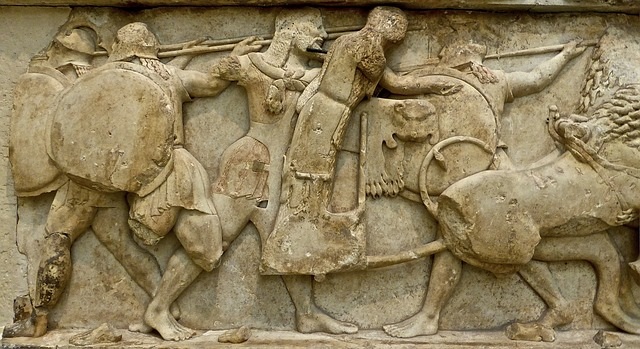Bas-relief
A bas-relief is a form of sculpture that is carved from a flat two-dimensional plane creating a three-dimensional appearance. The backgrounds are kept shallow from the raised features, usually between a fraction of an inch to a few inches deep. It was predominately used as a decorative feature in the ancient architecture of countries such as Egypt, Greece and Italy.
The term is French and is derived from the Italian basso-relievo (‘low relief’).
A bas-relief is created in one of two ways:
- By carving away material such as wood, stone, ivory, and so on.
- By applying material, such as strips of clay, to the top of an otherwise smooth surface.
The natural contours and shape of that being represented should be retained, which means that the bas-relief can be viewed from different angles without undue visual distortion.
Alto-relievo (high relief) is where the technique is applied to much deeper backgrounds, usually of between a foot and several feet in depth.
[edit] Related articles on Designing Buildings
- Architectural styles.
- Architrave.
- Classical orders in architecture.
- Cornice.
- Crocket.
- Elements of classical columns.
- Entablature.
- Fresco.
- Frieze.
- Gargoyle.
- Grotesque.
- Hunky punk.
- Large-scale murals.
- Moulding.
- Pedestal.
- Pediment.
- Pendentive dome.
- Pilaster.
- Rustication.
- Soffit.
- Stained glass.
- Strapwork.
- Tessera.
- The history of fabric structures.
- Trompe l’oeil.
- Tympanum.
IHBC NewsBlog
Images from inside a Grade II listed hotel show the scale of its collapse
The Corbett Arms in Tywyn has fallen into serious disrepair.
Old Sarum fire in listed (& disputed) WW1 Hangar - Wiltshire Council has sought legal advice after fire engulfed a listed First World War hangar that was embroiled in a lengthy planning dispute.
UK Antarctic Heritage Trust launches ‘Virtual Visit’ website area
The Trust calls on people to 'Immerse yourself in our heritage – Making Antarctica Accessible'
Southend Council pledge to force Kursaal owners to maintain building
The Council has pledged to use ‘every tool in the toolbox’ if urgent repairs are not carried out.
HE’s Research Magazine publishes a major study of the heritage of England’s suburbs
The article traces the long evolution of an internal programme to research 200 years of suburban growth
IHBC Context 183 Wellbeing and Heritage published
The issue explores issues at the intersection of heritage and wellbeing.
SAVE celebrates 50 years of campaigning 1975-2025
SAVE Britain’s Heritage has announced events across the country to celebrate bringing new life to remarkable buildings.
IHBC Annual School 2025 - Shrewsbury 12-14 June
Themed Heritage in Context – Value: Plan: Change, join in-person or online.
200th Anniversary Celebration of the Modern Railway Planned
The Stockton & Darlington Railway opened on September 27, 1825.
Competence Framework Launched for Sustainability in the Built Environment
The Construction Industry Council (CIC) and the Edge have jointly published the framework.














